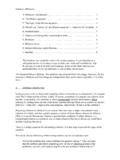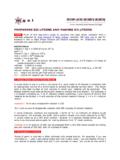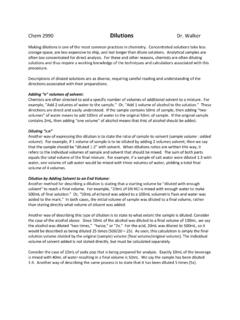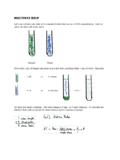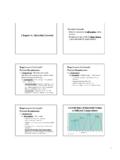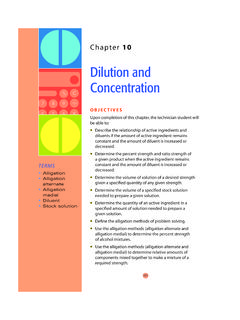Transcription of Solutions to: Solutions and Dilutions
1 Version 3 2/4/10 Solutions to: Solutions and Dilutions Learning objectives Students should be able to: Content Design a procedure for making a particular solution and assess the advantages of different approaches Choose the appropriate glassware to ensure the desired level of precision of a particular solution Convert between different concentration units ( , ppm to M) Process Develop alternative pathways for diluting Solutions (Information Processing) Design approaches for preparing Solutions (Problem Solving) Infer chemical processes based on reactions (Critical Thinking) Prior knowledge Types of glassware for preparing Solutions , including graduated cylinders, pipettes, burets, and volumetric flasks Correct method for reading and dispensing from a graduated cylinder, pipette, buret, and volumetric flask Definitions of primary standard, secondary standard, calibration standard, accuracy and precision, ppm, molarity Further Reading Harris, Quantitative Chemical Analysis, 7th Edition, 2007 WH Freeman: USA, Sections 2-5 and 2-6, p.
2 26-29. Skoog, West, Holler, Crouch, Fundamentals of Analytical Chemistry, 8th Edition, 2004 Thompson Brooks/Cole: USA, Sections 13B and 13C, p. 340-343. Louisiana Universities Marine Consortium (LUMCON) Bayouside Classroom, dissolved oxygen section, available at: Author(s): Mary Walczak (Shepherd) Christine Dalton Version 3 2/4/10 2 Solutions and Dilutions Consider Model 1. Shelby needs to make a M acetic acid solution from an acetic acid standardized solution that is M. The analytical equipment available to Shelby in the lab includes the volumetric flasks and pipettes shown below. Although several different size volumetric flasks are available, Shelby opts to use the 100-mL flask because it is both clean and dry. Key Questions: 1. What size pipette does Shelby need to use to make 100 mL of M acetic acid solution? Devise a general mathematical expression for calculating the concentration of the resulting solution.
3 C1V1=C2V215 M()V1=3 M()100 mL()V1=20 mL 2. The dilution factor (initial volume of solution/final volume of solution) is a way of expressing the extent to which a solution is diluted. What dilution factor is used to prepare the solution described in Q1? 20 mL100 mL=15 3. Shelby is not concerned about the dryness of the pipettes. Explain, based on proper pipetting techniques and your laboratory experiences, exactly how Shelby should use the pipette. Why does proper lab technique eliminate the need for dry pipettes? 250$mLTC$@$25 C100$mLTC$@$25 C50$mL500$mLTC$@$25 C25$mL 25mL 20mL 15mL 10mL 5mL Version 3 2/4/10 3 Shelby could rinse the pipette with small amounts of the concentrated solution three times to ensure that only droplets of that solution are in the pipette before measuring out solution to transfer. 4. Was it necessary for the volumetric flask to be dry?
4 Discuss as a group and explain your answer and reasoning in a grammatically complete sentence. No, because water is added to dilute the concentrated solution. Therefore, the flask needs only to be clean and contain only water. 5. Assign different volumetric flasks to group members. For each size flask, determine the volume necessary to prepare that volume of a M acetic acid solution from the M standard solution. Determine the dilution factor used to prepare any of these Solutions . Check your group s answers by comparing with other groups. Resolve any differences. As shown in the table below, three combinations of pipette/volumetric flask give a final solution concentration of 3 M: 20 mL into 100 mL; 10 mL into 50 mL; 5 mL into 25 mL. The dilution factor for all of these options is the same: 1/5. Diluting the acetic acid solution: stock 15 M desired 3 M pipette size flask size 5 10 15 20 25 500 250 100 3 50 3 6 25 3 6 9 12 15 6.
5 Suppose Shelby s supervisor said to make 250 mL of M acetic acid solution. How would you suggest Shelby prepare this solution? C1V1=C2V215 M()V1=3 M()250 mL()V1=50 mL Shelby does not have a 50-mL pipette available to make this solution. Multiple pipette deliveries are required. Any combination that gives a Version 3 2/4/10 4 total of 50 mL of the 15 M solution works. The best choice is to use the 25-mL pipette twice because that is the fewest number of transfers (see Rules of Thumb, below). 7. Shelby s supervisor asked for 100 mL of a M acetic acid solution. Could Shelby prepare this from the M standard solution using the available glassware in Model 1? If so, how? If not, what other glassware might Shelby want to use? C1V1=C2V215 M()V1=2 M()100 mL()V1= mL Shelby does not have a pipette that delivers mL! Using 10 mL gives a M solution and 15 mL gives M.
6 If the concentration must be precisely M, the solution must be prepared gravimetrically. Consider Making Solutions : Rules-of-Thumb Graduated cylinders are considerably less accurate and precise than glass transfer pipettes. dilution in one step is better than two. Larger glassware has less relative uncertainty. Measuring (Mohr) pipettes are less precise than glass transfer pipettes. Waste handling is expensive. Glassware is designed to hold a specific volume only at a stated temperature. Key Questions. Version 3 2/4/10 5 8. Considering the rules-of-thumb listed above, circle the glassware in each pair above that will provide the lower uncertainty. 9. Under what conditions is it advantageous to use the smaller volumetric flask in the center panel above? When is the larger flask the optimum choice? Compare answers with group members and arrive at a consensus.
7 It is advantageous to use the smaller volumetric flask in the center panel when the reagents and/or waste handling are expensive. Making less solution will reduce these costs. The larger flask is better in situations when precision is vitally important, because it has a lower relative uncertainty. Consider Model 2. Reagan is doing an atomic absorption experiment that requires a set of zinc standards in the ppm range. A 1000 ppm Zn solution was prepared by dissolving the necessary amount of solid Zn(NO3)2 in water. The standards can be prepared by diluting the 1000 ppm Zn solution. Table 1 shows one possible set of serial Dilutions (stepwise dilution of a solution) that Reagan could perform to make the necessary standards. Solution A was prepared by diluting mL of the 1000 ppm Zn standard to mL. Solutions C-E are called calibration standards because they will be used to calibrate the atomic absorption spectrometer.
8 Table 1. Dilutions of Zinc Solutions . Solution Zinc Solution Concentration (ppm Zn) Volume used (mL) Diluted Volume (mL) Solution Concentration (ppm Zn) Solution Concentration (ppm Zn(NO3)2) Solution Concentration (M Zn(NO3)2) Solution Concentration (M Zn) A 1000 x 102 x 102 x 10-3 x 10-3 B Solution A x 10-5 x 10-5 C Solution B x 10-6 x 10-6 D Solution B x 10-5 x 10-5 E Solution B x 10-5 x 10-5 Version 3 2/4/10 6 Key Questions. 10. Using your general scheme for calculating the concentration of diluted Solutions devised in key question 1, calculate the resulting concentration (ppm Zn) for each solution A-E above. Enter your answers into the diagram at the right and into the boxes in Table 1. Verify answers provided in Table 1. C1V1=C2V2 Since the standard is 1000 ppm Zn, the straightforward dilution calculation suffices.
9 11. The atomic mass of Zn is amu and the molar mass of Zn(NO3)2 is amu. Devise a scheme to calculate the solution concentrations in units of ppm Zn(NO3)2. Calculate the resulting solution concentrations in ppm Zn(NO3)2 for Solutions A-E. Enter your results in Table 1. Here the concentrations must be converted to ppm Zn(NO3)2 before using the dilution equation. 1000 ppm Znmole g Zn1 mole ZnNO3()21 mole g ZnNO3()2mole ZnNO3()2=2896 ppm ZnNO3()2 12. Devise a scheme to calculate the solution concentrations in units of molarity (M Zn(NO3)2) and (M Zn). Calculate the resulting solution concentrations in M Zn(NO3)2 and M Zn for Solutions A-E. Enter your results in Table 1. 1000 g Zn106 g solutionmole g Zn1 g solution1 mL solution1000 mLL= x 10 2 M Zn1000 g Zn106 g solutionmole g Zn1 mole ZnNO3()21 mole Zn1 g solution1 mL solution1000 mLL= x 10 2 M ZnNO3()2 1000 ppm Zn standard 100 ppm Zn (Sol A) ppm Zn calibration standard (Sol C) (Sol D) (Sol E) 5 ppm Zn (Sol B) ppm Zn calibration standard ppm Zn calibration standard Version 3 2/4/10 7 13.
10 Compare the solution concentrations expressed as ppm Zn and ppm Zn(NO3)2. Compare the concentrations expressed as M Zn and M Zn(NO3)2. Which units allow easy conversion between chemical species ( , Zn and Zn(NO3)2)? The solution concentrations expressed as ppm Zn and ppm Zn(NO3)2 are not numerically equivalent. The Molarity concentrations, however, do not depend on the compound of interest ( , Zn or Zn(NO3)2). The difference is due to ppm being based on mass of analyte ( , Zn or Zn(NO3)2), which is different in the two cases. For molarity, the concentration is based on the number of moles of analyte, which is the same for Zn or Zn(NO3)2. Which units express concentrations in numbers with easily expressed magnitudes? The solution concentrations expressed as ppm Zn and ppm Zn(NO3)2 are easily expressed numbers for Solutions in this concentration range.
